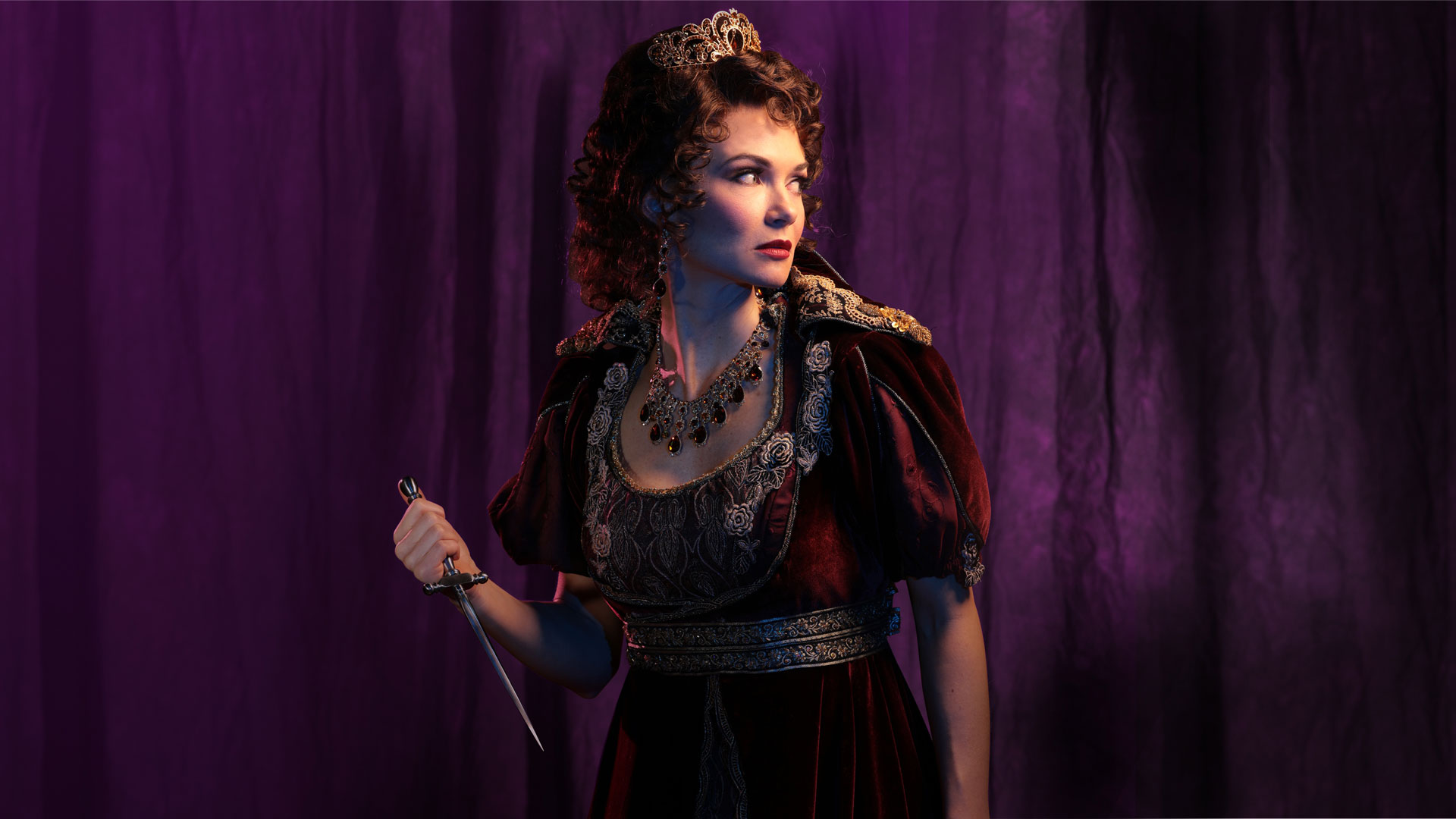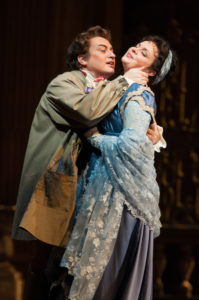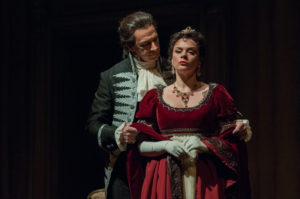Tosca 101 – Characters and Synopsis

By: Suzanne Whitney
“I lived for art. I lived for love.” These famous words of Floria Tosca have endeared her to so many opera lovers over the years. And while Puccini’s Tosca holds many beautiful moments of tenderness, this opera is a wild ride of jealousy, lust, political intrigue, and betrayal.
It is hard to believe Puccini composed the political thriller Tosca directly after La bohème, one of the most tender love stories of our time. However, Puccini had his eyes on this story for years. Based on French playwright Victorien Sardou’s La Tosca, Puccini spent years working with his publisher to gather the rights to adapt the play for the operatic stage. Once you see this heart-racing drama, you will understand why. Learn a little about the basics of this beloved opera in the first installment of Tosca 101.
The Creators
Composer – Giacomo Puccini (December 1858 – November 1924)
Librettists – Luigi Illica (May 1857 – December 1919) and Giuseppe Giacosa (October 1847 – September 1906)
Source Material – La Tosca, a five-act play written by Victorien Sardou (September 1831 – November 1908)
The Characters
Floria Tosca (soprano) – One of Rome’s premier opera singers. Played by returning Opera Colorado favorite Melissa Citro, who previously tackled another of Puccini’s heroines as Minnie in Opera Colorado’s 2016 production of La fanciulla del West.
Mario Cavaradossi (tenor) – A painter and Tosca’s lover. Played by Rafael Davila, who is making his Opera Colorado debut.
Barone Scarpia (baritone) – Rome’s chief of police. Played by Luis Ledesma, who is making his Opera Colorado mainstage debut, but was seen at our first in-person event of 2021 Canciones de nuestras Tierras at Denver Botanic Garden.
Sacristan (bass) – The caretaker of the Attavani family chapel. Played by Stefano de Peppo, well known to opera Colorado audiences for his masterful portrayal of Dr. Bartolo in The Marriage of Figaro and The Barber of Seville.
Cesare Angelotti (bass) – An escaped political prisoner and friend to Cavaradossi. Played by Phillip Lopez, one of the 2021-22 Opera Colorado Artists in Residence.
The Setting
Rome in June of 1800. In the midst of Napolean’s invasion of Italy.
The Plot
Act 1 – The Attavani Family Chapel at the basilica of Sant’Andrea della Valle in Rome.
Curtains rise on Cesare Angelotti, a newly escaped political prisoner and former leader of the Napoleonic forces, searching for sanctuary at his family’s private chapel. He finds the key his sister, the Marchesa Attavani, hid for him and rushes inside. Angelotti hides as the sacristan, and then Mario Cavaradossi, a painter, enters the chapel.
Cavaradossi is working on a portrait of Mary Magdalene. He explains to the sacristan the hidden harmony of his two muses: the lovely blonde Marchesa Attavani and Floria Tosca, his dark-haired lover.

Photo: Seattle Opera
The moment the sacristan leaves, Angelotti reveals himself to his friend Cavaradossi, and they greet each other warmly. Their reunion is brief, as Angelotti must hide upon hearing the ringing voice of Floria Tosca from outside. Tosca enters demanding to know why the door was locked, accusing Cavaradossi of being with another woman. Her suspicions only deepen as she sees the blonde, blue-eyed portrait of Mary Magdelene. Cavaradossi reassures Tosca of his fidelity, and the two agree to meet at his apartments after Tosca’s performance that evening.
Angelotti and Cavaradossi renew their discussion of how to keep Angelotti safe, only to be interrupted by a cannon shot—indicating the police know of Angelotti’s escape. The two friends flee to the safety of Cavaradossi’s home, where they can hide Angelotti in an old well.
The sacristan returns to rehearse a Te Deum with the choir boys for a celebration of Napolean defeat. Then the Barone Scarpia, Rome’s chief of police, enters, searching for the escaped Angelotti. He finds evidence Angelotti has been there and correctly assumes Cavaradossi is hiding his friend.
Tosca enters, looking for Cavaradossi again. Sensing her tendency towards jealousy, Scarpia decides to play the two lovers against each other. He convinces her Cavaradossi has been unfaithful and sends her chasing after him in a jealous rage. Scarpia’s men follow her, hoping to find Angelotti hiding with Cavaradossi. With the sound of the Te Deum swelling behind him, Scarpia vows to have Tosca for his own.
Act 2 – The Palazzo Farnese
Curtains rise on Scarpia in his apartments at the Palazzo Farnese, thinking lecherous thoughts about Tosca. Spoletta, one of Scarpia’s spies, arrives with the news they have been unable to find Angelotti, but they have arrested Cavaradossi. Scarpia interrogates Cavaradossi, and through the window, both hear Tosca performing in the courtyard.
Scarpia sends for Tosca, demanding for information about Angelotti. She refuses until Scarpia begins to torture Cavaradossi. Unable to watch her love in pain, Tosca gives up Angelotti’s location and begs clemency for Cavaradossi.

As he becomes aware of what has happened, Cavaradossi is infuriated by Tosca’s actions. But then news arrives, announcing a change in the battle. Napoleon is now winning and marching on Rome. Cavaradossi cannot help but celebrate this turn of events; however, his gloating cries of defiance enraged Scarpia. The police drag Cavaradossi away to be executed.
Now alone in the room, Scarpia offers Tosca a cruel ultimatum: submit to his lustful desires or trigger the execution of her beloved. Horrified, Tosca pleads for mercy, repeatedly rejecting his advances. She offers money, but he refuses. Scarpia only wants her. Realizing there is no other way, Tosca finally agrees.
Scarpia explains there will be a mock execution, but slyly he orders his men to prepare a real one. Tosca demands he provide a letter of safe conduct for herself and Cavaradossi. As he sits down to write the letter, Tosca spies a dagger, which she quietly palms. Scarpia completes the letter and rises to defile Tosca, only to be met with the sharp end of his own blade. “This is the kiss of Tosca,” she defiantly cries, taking the letter of safe conduct and fleeing.
Act 3 – The Castel Sant’Angelo
It is dawn the following day. Cavaradossi bribes a jailer for pen and paper to write Tosca a final love letter. Much to his surprise, Tosca rushes in with news the two of them have safe passage and the execution will only be for show. She gives him a lesson in theatrics, teaching him how to feign an execution. They spend a tender moment dreaming of their future together after their escape, only to be interrupted by the firing squad’s arrival.
Tosca waits with bated breath. The firing squad takes their place. They shoot. Cavaradossi drops to the ground. Tosca quietly appreciates Cavaradossi’s performance. Once the firing squad exits, she runs to Cavaradossi, only to discover he is truly dead.
A shout goes up. Scarpia is dead. Tosca knows she is the prime suspect. With the police closing in, Tosca makes a decision. From the roof of the Castel Sant’Angelo, she leaps to her death.
If you made it through this whole post, you deserve to enjoy some of the music from this masterpiece! Watch tenor Rafael Davila perform the iconic aria, “E lucevan le stelle” and learn some fun facts about it too!>>
—
What is your favorite moment in Tosca? Is there anything you are dying to know about the opera or our production? Let us know in the comments below!



How long does this production of Tosca last?
This production will be on stage at the Ellie Caulkins Opera House in Denver November 6-14, 2021. You can find all the details here: https://www.operacolorado.org/event/puccinis-tosca-21/